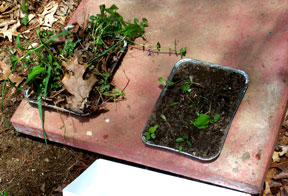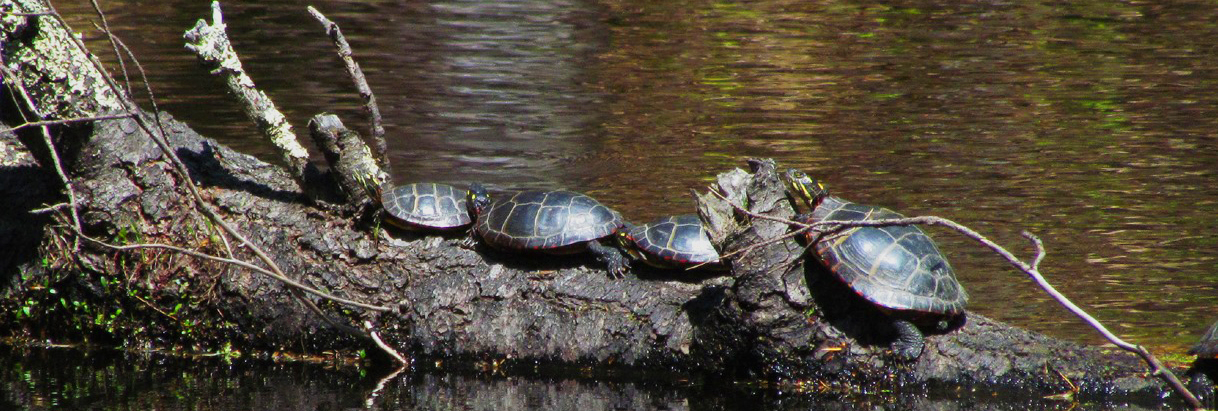Lesson 4b Stream Walk
Extra experiments to help understand the impact of the riparian buffer zone, bank erosion, and shade.
Experiments can be designed to answer some of the questions. For section 1, put soil covered by plants in one container (square or rectangular pan) and soil with little or no vegetation in a second similar container. Set both pans on an incline. Pour equal amounts of water over each container and collect the water that spills out into separate containers. Label each sample of collected water - plant cover, no cover. How are the water samples different? Why did this happen?

For section 2, set two identical pans of water outside. Completely shade one pan by placing it under a tree or bush, but only partially shade the other. Test the temperature of each pan after an hour. How are the water temperatures different? Why did this happen?
For section 3, repeat the experiment for section 1, except use more water, causing more erosion. For section 6, use plastic gutters to form a river bed. Set the gutters up outside. In one section of the gutter, cover the bottom with rocks and pebbles. In another section, cover the bottom with clay and a few pebbles. Use a hose connected to an outside faucet to create a water flow in the river. Watch to see how the water acts as it flows over the rocks and then over the clay. Try sprinkling sand in the water to see if the sand collects in the rocks. For section 7, build a dam across the gutter (from section 6) using clay, then send water, small branches, plastic fish, sand, etc. down the river. What happens above the dam? What happens below the dam? How would a dam affect a river?
Focus:
Why is the riparian buffer zone important to a river? What causes bank erosion? How is a river affected by bank erosion?
Materials:
__2 identical pans, such as aluminum baking pans available at the grocery store
__2 cut sections of “sod” the same size as the pans, one that is soil covered by plants, leaves, and __decaying matter, and the other is soil covered by few or no plants
__a white container for collecting run off
__a watering can with rain spout
__measuring cup
Procedures:
1. Place the plant covered “sod” in one pan and the “sod” with few plants in the other pan. Disturb the “sod” as little as possible.
2. Set the pans outside on an incline that is high enough so you can collect water below the pans.
3. Place the white water collection container below one of the pans.
4. Fill the watering can with 4 cups of water, then slowly pour the water down over the same pan of sod.
5. Inspect the water that runs into the collection container.
6. Repeat for the other pan of “sod.”
Repeat this experiment to show bank erosion, but pour more water at a faster rate into the pans. Try 8 or 12 cups of water.
Discussion:
What was the difference in the runoff water you collected?
Would it be better to have lots of plants and ground cover on the land next to a river? Why?
What happens when few plants are growing in the riparian buffer zone?
Focus:
How does shade help a river?
Materials:
__2 identical pans, trays, bowls, etc.
__2 thermometers
__measuring cup
__pail of cold water
Procedure:
1. Put one pan outside in the shade.
2. Fill it with water.
3. Place the other pan in the sun.
4. Fill it with an equal amount of water.
5. Put a thermometer in the water in each pan.
6. After an hour, check the temperature of the water in each pan.
Discussion:
Were there differences in the water temperatures?
Why did this happen?
Is it good to have lots of trees, bushes, and other tall plants growing in the riparian zone? Why?
Data Sheets for Students Doing a Streamwalk
Streamwalk – Chart 1: Comparing the Data Collected by Different Teams
|
Lamprey River watershed |
date |
time |
|
location |
beginning landmark |
ending landmark |
|
photos taken |
beginning latitude: longitude: |
ending latitude: longitude: |
Is the stream adequate or inadequate?
|
Teams |
#1 |
#2 |
#3 |
#4 |
#5 |
|
How wide are the riparian buffer zones? |
|||||
|
How much of the water surface is shaded at mid-day? |
|||||
|
Are the river banks eroding? |
|||||
|
Is the water clear? |
|||||
|
Can you see algae growing on the rocks? |
|||||
|
What is the make up of the point bars? |
|||||
|
Can you see a variety of habitats? |
|||||
|
Are the riffle areas made of large or small particles? |
|||||
|
Do any barriers block the flow of the river? |
|||||
|
Do you see any pipes, culverts, or trash? |
|||||
|
Is the natural vegetated buffer intact or has it been changed? Lawn? Bare soil? |

